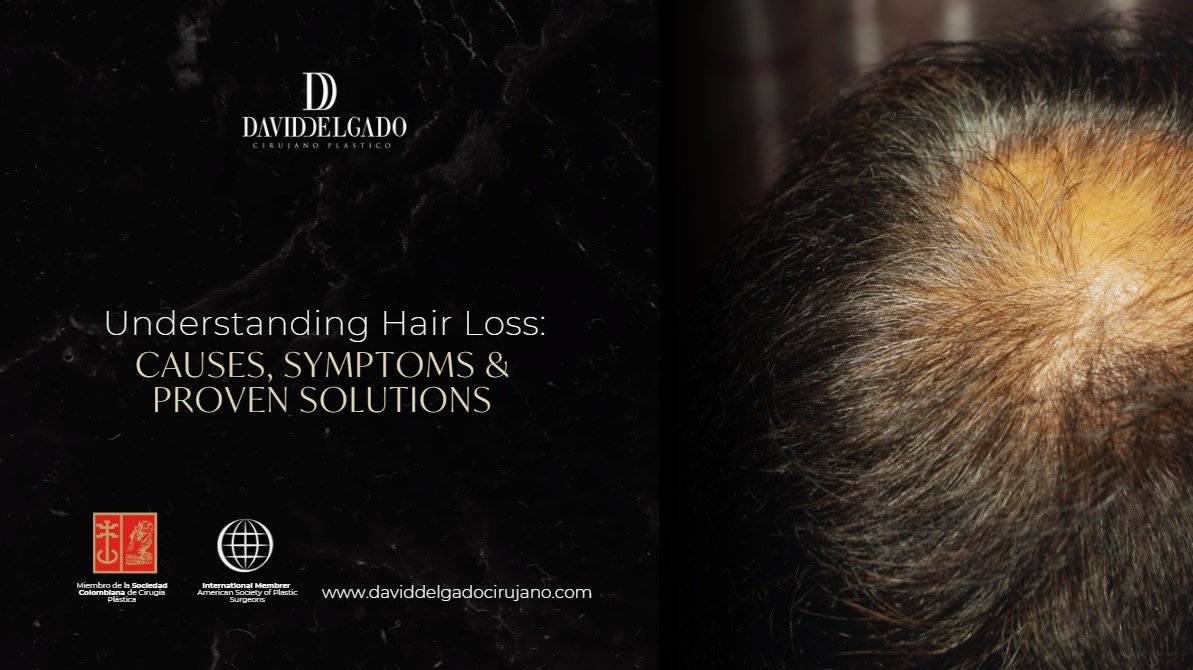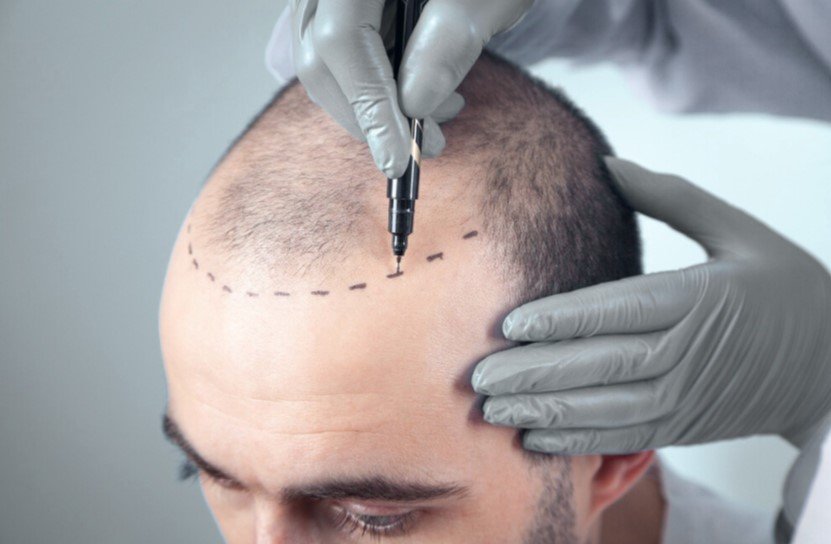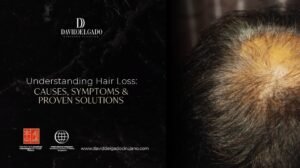
Have you noticed more hair than usual on your pillow, brush, or shower drain? You’re not alone. Alopecia bald, commonly known as baldness, is one of the top reasons why both men and women come to see me at my clinic in Medellín. Beyond appearances, hair loss is often a sign of internal issues that need proper understanding and treatment.
As a plastic surgeon with expertise in hair restoration, I’ve worked with hundreds of patients who arrive feeling anxious, wondering why their hair is falling out, whether they have alopecia bald, or if it’s just a temporary condition. In many cases, what seems like a cosmetic issue is actually related to hormonal imbalances, autoimmune disorders, or even chronic stress.
When we talk about hair loss, it’s not only about going bald. It’s also about thinning hair, areas of the scalp where hair becomes progressively finer and more fragile. It’s about the emotional burden that balding can bring, the dip in self-esteem, and the fear of not recognizing yourself in the mirror anymore.
In this guide, I’ll explain the real causes of hair loss, the various types of alopecia, the symptoms you should monitor, and the range of medical solutions available today—from noninvasive treatments to advanced surgical techniques.
Table of Contents
What Is Alopecia?
As a hair restoration specialist, I believe it’s essential for patients to understand the medical meaning behind the word alopecia. Alopecia bald, commonly known as baldness, refers to an abnormal condition of hair loss that can be localized or widespread. While many people use “hair loss” and “alopecia” interchangeably, they’re not the same from a clinical perspective.
How is alopecia bald different from normal hair shedding?
It’s completely normal to lose 50 to 100 hairs per day as part of the natural hair growth cycle. However, when the shedding becomes excessive or constant, or noticeable bald spots appear, we’re looking at a medical condition: hair loss alopecia.
Alopecia is not a single disease; it’s a general term that includes different types of hair loss, each with distinct causes, symptoms, and treatments. These are the most common ones I treat in my practice:
Common Types of Alopecia
Alopecia Areata
An autoimmune disorder where the immune system mistakenly attacks hair follicles. It often causes sudden round patches of hair loss.
Androgenetic Alopecia
Also known as male or female pattern baldness, it’s the most common form of alopecia bald. It’s hereditary and hormonally driven, usually starting in adolescence or early adulthood, especially in men.
Telogen Effluvium
This temporary condition is triggered by physical or emotional stress, such as surgery, high fever, childbirth, or grief. Hair typically grows back once the cause is resolved.
Traction Alopecia
Caused by constant tension on the hair, usually due to tight hairstyles like braids, ponytails, or extensions. It’s often reversible if detected early.
Scarring Alopecia
In this form, the follicle is permanently destroyed and replaced by scar tissue, preventing hair from growing back. It can result from infections, burns, or inflammatory skin diseases.
Who Can Develop Alopecia?
Alopecia can affect anyone. I’ve treated patients of all ages—men, women, and even children. While some types, like androgenetic alopecia, are more common in adults, others, like alopecia areata, can begin at any age.
Beyond the physical changes, hair loss can deeply affect a person’s self-esteem, body image, and social interactions. Many of my patients arrive feeling embarrassed, insecure, or anxious. Understanding what causes alopecia hair loss is the first step toward regaining confidence and finding a personalized treatment solution.
Causes of Hair Thinning and Loss
One of the most frequent questions I hear from patients is, “What could be causing my hair to fall out?” While the answer is rarely one-size-fits-all, it is always rooted in proper diagnosis. There are multiple causes of hair thinning and loss, and understanding them is the key to treating the issue effectively.
From my clinical experience, these are the most common reasons behind hair thinning and hair loss:
| Cause | Description |
|---|---|
| 1. Hereditary and Genetic Factors | Genetics play a major role in hair loss. If hair thinning or baldness runs in your family, chances are you may also develop it. Patterns include receding hairlines or crown thinning. |
| 2. Hormonal Changes | Common in women, hormonal imbalances from menopause, PCOS, thyroid issues, or postpartum changes can disrupt the hair growth cycle, leading to thinning or shedding. |
| 3. Chronic Stress and Mental Health | Emotional stress, anxiety, or depression can lead the body to deprioritize hair growth, resulting in temporary but noticeable shedding. |
| 4. Autoimmune Diseases | Conditions like lupus, Hashimoto’s thyroiditis, and alopecia areata cause the immune system to attack hair follicles, leading to hair loss—often in women. |
| 5. Nutritional Deficiencies | Lack of iron, vitamin D, zinc, or biotin can weaken hair health, especially in those with heavy menstruation, poor diets, or eating disorders. |
| 6. Medications and Treatments | Drugs like chemotherapy, birth control, antidepressants, or blood thinners may cause hair loss. Some cases are reversible; others need specialized care. |
| 7. Lifestyle Habits & Damage | Tight hairstyles, excessive heat, chemical treatments, and extensions can damage follicles over time, leading to breakage and long-term thinning. |
Understanding what can cause hair loss is the foundation of any effective treatment plan. My role as a specialist is not just to treat the symptom but to help you uncover the root cause and restore your hair—and your confidence—through a personalized approach.
Recognizing the Early Signs of Balding and Hair Thinning
One of the keys to treating hair loss successfully is acting early. Spotting the initial signs of hair thinning can be the difference between a simple fix and a complex treatment.
As a surgeon specialized in alopecia bald, here are the warning signs I often see in patients:
- Excessive Hair Shedding: If you're seeing more hair on your pillow, brush, or in the shower drain, it might be more than a seasonal shed. While daily hair loss is normal, constant or large amounts of hair falling out are a red flag.
- Appearance of Bald Spots: The sudden emergence of a bald spot, whether circular or irregular, is often one of the first visible signs of alopecia areata or localized hair loss.
- Thinning in Key Areas: You may not lose big clumps of hair, but thinning around the hairline, crown, or part is often the first sign of something more chronic. Hair thinning can quietly progress over time without proper care.
- Decrease in Hair Volume and Density: Has your hairstyle changed shape? Is your ponytail thinner? These subtle changes can indicate balding in its early stages—even if there's no obvious hair loss yet.
- When to See a Specialist: If you’re asking yourself “why is my hair falling out?” and recognizing any of these signs, it’s time to consult a professional. A proper diagnosis is essential to determine the cause and type of hair loss and start the right treatment.

Types of Hair Loss: Temporary vs. Permanent
Not all hair loss is the same. Some forms are reversible and short-term, while others are permanent and progressive. Understanding the types of hair loss is crucial for determining your ideal treatment.
| Type of Hair Loss | Description |
|---|---|
| Telogen Effluvium – Temporary | Often triggered by physical or emotional stress such as surgery, high fever, or childbirth. Hair enters a resting phase and sheds heavily but usually regrows over time. |
| Anagen Effluvium – Temporary but Aggressive | Typically caused by chemotherapy or strong medications. Hair loss is rapid and extensive, but hair often regrows after treatment is discontinued. |
| Androgenetic Alopecia – Permanent and Progressive | The most common type of hair loss in adults, linked to genetic and hormonal factors. It progresses gradually and requires treatment to slow or reverse. |
| Alopecia Areata – Can Be Temporary or Long-Term | An autoimmune condition that can cause sudden patchy hair loss. It may resolve on its own or become chronic. Medical guidance is essential. |
| Scarring Alopecia – Permanent and Irreversible | This rare condition destroys hair follicles and replaces them with scar tissue. Once damaged, hair cannot regrow. Early diagnosis is crucial. |
A clinical diagnosis is essential. In my practice, we perform scalp analysis, trichoscopy, and lab testing when needed. Knowing what type of hair loss, you’re dealing with is the first step to an effective and personalized solution.
What Causes Baldness in Men and Women?
One of the most common concerns I hear from patients is, “Doctor, why is my hair falling out so much?” Understanding what causes baldness is the first step to addressing it effectively. Hair loss is rarely the result of a single issue—it’s usually a combination of factors.
1. DHT and Genetic Predisposition
A major factor in hair loss alopecia is DHT (dihydrotestosterone), a hormone derived from testosterone. In genetically predisposed individuals, DHT binds to hair follicle receptors and gradually weakens them, leading to thinner hair and eventually no growth at all.
2. Male-pattern baldness
Male pattern baldness usually starts with a receding hairline or a thinning crown. This is one of the most common forms of alopecia bald, and it progresses slowly but surely if not treated in time.
3. Female-patterned hair loss
In women, hair loss usually appears as a general thinning around the top of the scalp, rather than distinct bald spots. While it’s often mistaken for stress or nutrition issues, it can also be caused by hormonal or genetic factors.
4. Hormonal Fluctuations: Pregnancy, Menopause, and More
The female hormonal cycle directly impacts hair health. Postpartum hair loss, menopause, and thyroid disorders are all common triggers of hair loss alopecia, particularly in those with a family history.
5. Myths and Facts About Baldness
There are plenty of myths surrounding what causes alopecia hair loss—like wearing hats, washing hair too often, or thinking it’s untreatable. As a specialist, I focus on facts, accurate diagnoses, and tailored treatment plans for each unique case.
How to Prevent Hair Loss: Everyday Habits and Lifestyle Changes
When patients inquire about hair loss prevention, they frequently anticipate a miraculous cure. But prevention begins with simple, daily habits that strengthen the scalp and follicles before damage occurs.
Here are the key principles I recommend:
| Preventive Habit | Description |
|---|---|
| Scalp Hygiene and Care | A clean and balanced scalp is essential for healthy hair. Keeping it free from buildup, oil, and harsh products prevents inflammation and damage to the follicles. |
| Nutrient-Rich, Balanced Diet | A diet high in protein, iron, zinc, vitamin D, and biotin supports hair strength and growth. Many causes of hair thinning and loss are linked to nutritional deficiencies. |
| Stress Management | Chronic stress is a major trigger of hair loss. Techniques like mindfulness, regular physical activity, and emotional support can greatly reduce its negative effects. |
| Quality Sleep | Sleep regulates hormones and cellular repair. Restful, consistent sleep improves overall wellness and helps prevent alopecia bald and other types of hair loss. |
| Protective Hairstyles and Less Heat | Avoid tight hairstyles and frequent use of hot tools or harsh chemicals. Gentle, protective styling plays a key role in how to prevent baldness long term. |
| Early Prevention Beats Late Intervention | Don’t wait until major shedding starts. The earlier thinning or fragility is addressed, the better the outcome. In hair medicine, time is critical. |
Real Hair Loss Treatment Options: Advanced Technology and Natural Results
In my plastic surgery practice in Medellín, I focus exclusively on medically proven, highly effective treatments for alopecia bald. I don’t offer miracle cures or over-the-counter solutions—only personalized, science-based strategies that deliver visible, lasting results.
Currently, the most advanced treatments I offer are FUE hair transplantation and robotic-assisted hair restoration using ARTAS technology. These are minimally invasive techniques that provide natural-looking outcomes with shorter recovery times.
FUE Hair Transplant (Follicular Unit Extraction)

The FUE technique involves extracting individual hair follicles from a donor area—typically the back of the scalp—and implanting them into areas affected by alopecia bald. This method is precise, leaves no linear scarring, and offers a faster healing process compared to traditional transplants.
My patients especially appreciate how natural the result looks. The transplanted hair grows like normal and blends seamlessly with the rest of the scalp.
Robotic-Assisted Hair Transplant with ARTAS Technology
In our clinic, we also perform robotic-assisted FUE using the ARTAS system—the most advanced technology in surgical hair restoration available and the only one of its kind currently operating in Colombia. ARTAS uses artificial intelligence to precisely identify and select the optimal follicles for extraction, ensuring unparalleled accuracy and superior aesthetic outcomes.
This cutting-edge system improves the efficiency of the FUE procedure, reduces surgical time, and protects the donor area by extracting only the healthiest follicles. The result? Higher density, reduced trauma, and incredibly natural-looking results.
It’s the ideal solution for patients seeking a minimally invasive, high-tech treatment with fast recovery, long-term benefits, and the confidence of knowing they’re receiving care with the most advanced and exclusive technology available in the country.

Which Option Is Right for You?
Whether you’re a candidate for classic FUE or robotic-assisted restoration with ARTAS depends on factors like donor hair density, size of the area to be treated, your lifestyle, and your cosmetic goals.
My approach is not just surgical—it’s personal. I work closely with each patient to design the hairline, plan graft distribution, and ensure that the result doesn’t just restore hair but restore confidence. In hair medicine, time truly matters.
Why Choose Dr. David Delgado in Medellín for Hair Loss Treatments?

As a board-certified plastic surgeon with a specialization in hair restoration, my mission is to offer treatments that truly improve my patients’ lives. I use advanced surgical techniques like FUE and the ARTAS robotic system to deliver results that look natural and complement each person’s facial features.
My clinic in Medellín welcomes both local and international patients, offering full support and continuous follow-up before, during, and after every procedure. If you’re looking for a trusted, expert, and human approach to solving your alopecia bald concerns, I would be honored to guide you. Schedule your personalized consultation today and take the first step toward restoring not just your hair, but your confidence.
Frequently Asked Questions About Hair Loss and Alopecia bald
1. What is alopecia bald and how is it different from normal hair shedding?
Alopecia bald is a medical condition that causes abnormal hair loss, either localized or generalized, in both men and women. Unlike normal daily shedding—which ranges from 50 to 100 hairs—alopecia involves progressive, persistent, and often visible thinning or baldness. It may be triggered by genetic, hormonal, autoimmune, or environmental factors.
2. Why is my hair falling out?
Hair loss can have many causes: genetic predisposition, hormonal imbalances, chronic stress, autoimmune disorders, or nutritional deficiencies. For women, postpartum periods and menopause can also be triggers. To know exactly what’s causing your hair to fall out, a personalized medical assessment is essential.
3. What are the early signs that I might be developing alopecia?
Early signs include hair thinning, noticeable shedding in the shower or on your pillow, reduced volume, and the appearance of a bald spot. Acting on these early signs can prevent more severe damage and preserve hair density.
4. What types of hair loss exist?
There are several types of hair loss, each with distinct causes and treatments:
- Androgenetic alopecia (hereditary and hormonal)
- Alopecia areata (autoimmune)
- Telogen effluvium (stress-induced and temporary)
- Scarring alopecia (irreversible follicle destruction)
Proper diagnosis is key to choosing the right treatment.
5. Is baldness reversible?
It depends on the type of alopecia bald. Conditions like telogen effluvium or mild alopecia areata can be reversed with medical support. However, in androgenetic alopecia or scarring alopecia, the damage is often permanent, and surgical treatments like hair transplants become the best option.
6. What treatments does Dr. David Delgado offer for alopecia bald?
I offer two advanced surgical treatments: FUE hair transplant and robotic-assisted hair restoration with ARTAS technology. These procedures are minimally invasive, provide natural-looking results, and are designed to fit each patient’s individual condition and goals.
7. Does a hair transplant hurt? What’s the recovery like?
The procedure is minimally invasive and performed under local anesthesia, so there is no pain during the surgery. Most patients return to normal activities within a few days. Visible results begin to appear between months 3 and 6, with full growth achieved in about a year.
8. Can I prevent hair loss before it becomes irreversible?
Yes. In many cases, hair loss can be prevented or slowed down by maintaining a healthy scalp, eating a balanced diet, managing stress, avoiding harsh hairstyles, and responding early to the first signs of hair thinning.
9. Can women get hair transplants too?
Absolutely. More and more women are opting for hair transplantation to address diffuse thinning or localized hair loss. The FUE technique is safe and effective for female patients who have a suitable donor area. A proper evaluation is necessary to determine eligibility.
10. When should I see a specialist?
If you notice persistent thinning, unusual shedding, or bald spots, don’t wait. The earlier you address hair loss alopecia, the more treatment options you’ll have and the better the outcomes. Early diagnosis is essential in hair restoration medicine.






